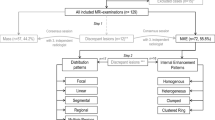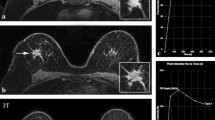Abstract
Purpose
To analyze the association of breast non-mass enhancement descriptors in the BI-RADS 5th edition with malignancy, and to establish a grading system and categorization of descriptors.
Materials and methods
This study was approved by our institutional review board. A total of 213 patients were enrolled. Breast MRI was performed with a 1.5-T MRI scanner using a 16-channel breast radiofrequency coil. Two radiologists determined internal enhancement and distribution of non-mass enhancement by consensus. Corresponding pathologic diagnoses were obtained by either biopsy or surgery. The probability of malignancy by descriptor was analyzed using Fisher’s exact test and multivariate logistic regression analysis. The probability of malignancy by category was analyzed using Fisher’s exact and multi-group comparison tests.
Results
One hundred seventy-eight lesions were malignant. Multivariate model analysis showed that internal enhancement (homogeneous vs others, p < 0.001, heterogeneous and clumped vs clustered ring, p = 0.003) and distribution (focal and linear vs segmental, p < 0.001) were the significant explanatory variables. The descriptors were classified into three grades of suspicion, and the categorization (3, 4A, 4B, 4C, and 5) by sum-up grades showed an incremental increase in the probability of malignancy (p < 0.0001).
Conclusion
The three-grade criteria and categorization by sum-up grades of descriptors appear valid for non-mass enhancement.






Similar content being viewed by others
Abbreviations
- ADC:
-
Apparent diffusion coefficient
- BI-RADS:
-
Breast imaging reporting and data system
- CI:
-
Confidence interval
- CNB:
-
Core needle biopsy
- DCE:
-
Dynamic contrast enhancing
- MIP:
-
Maximum intensity projection
- MRI:
-
Magnetic resonance imaging
- NME:
-
Non-mass enhancement
- NMLE:
-
Non-mass-like enhancement
- OR:
-
Odds ratio
- PPV:
-
Positive predictive value
- ST-:
-
Stereotactic-
- US:
-
Ultrasound
- VAB:
-
Vacuum-assisted biopsy
References
D’Orsi C, Sickles EA, Mendelson EB, Morris EA. Breast imaging reporting and data system: ACR BI-RADS breast imaging atlas. 5th ed. Virginia: American College of Radiology; 2013.
Sakamoto N, Tozaki M, Higa K, Tsunoda Y, Ogawa T, Abe S, et al. Categorization of non-mass-like breast lesions detected by MRI. Breast Cancer. 2008;15:241–6.
Tozaki M, Igarashi T, Fukuda K. Breast MRI using the VIBE sequence: clustered ring enhancement in the differential diagnosis of lesions showing non-mass-like enhancement. AJR Am J Roentgenol. 2006;187:313–21.
Gutierrez RL, DeMartini WB, Eby PR, Kurland BF, Peacock S, Lehman CD. BI-RADS lesion characteristics predict likelihood of malignancy in breast MRI for masses but not for nonmasslike enhancement. AJR Am J Roentgenol. 2009;193:994–1000.
Mahoney MC, Gatsonis C, Hanna L, DeMartini WB, Lehman C. Positive predictive value of BI-RADS MR imaging. Radiology. 2012;264:51–8.
Shimauchi A, Ota H, Machida Y, Yoshida T, Satani N, Mori N, et al. Morphology evaluation of nonmass enhancement on breast MRI: effect of a three-step interpretation model for readers’ performances and biopsy recommendations. Eur J Radiol. 2016;85:480–8.
Uematsu T, Kasami M. High-spatial-resolution 3-T breast MRI of nonmasslike enhancement lesions: an analysis of their features as significant predictors of malignancy. AJR Am J Roentgenol. 2012;198:1223–30.
Machida Y, Tozaki M, Shimauchi A, Yoshida T. Two distinct types of linear distribution in nonmass enhancement at breast MR imaging: difference in positive predictive value between linear and branching patterns. Radiology. 2015;276:686–94.
Yuen S, Uematsu T, Masako K, Uchida Y, Nishimura T. Segmental enhancement on breast MR images: differential diagnosis and diagnostic strategy. Eur Radiol. 2008;18:2067–75.
Gity M, Ghazi Moghadam K, Jalali AH, Shakiba M. Association of different MRI BIRADS descriptors with malignancy in non mass-like breast lesions. Iran Red Crescent Med J. 2014;16:e26040.
Imamura T, Isomoto I, Sueyoshi E, Yano H, Uga T, Abe K, et al. Diagnostic performance of ADC for non-mass-like breast lesions on MR imaging. Magn Reson Med Sci. 2010;9:217–25.
de Almeida JR, Gomes AB, Barros TP, Fahel PE, Rocha Mde S. Predictive performance of BI-RADS magnetic resonance imaging descriptors in the context of suspicious (category 4) findings. Radiol Bras. 2016;49:137–43.
Cho YH, Cho KR, Park EK, Seo BK, Woo OH, Cho SB, et al. Significance of additional non-mass enhancement in patients with breast cancer on preoperative 3T dynamic contrast enhanced MRI of the breast. Iran J Radiol. 2016;13:e30909.
Tozaki M, Fukuma E. 1H MR spectroscopy and diffusion-weighted imaging of the breast: are they useful tools for characterizing breast lesions before biopsy? AJR Am J Roentgenol. 2009;193:840–9.
Weinstein SP, Hanna LG, Gatsonis C, Schnall MD, Rosen MA, Lehman CD. Frequency of malignancy seen in probably benign lesions at contrast-enhanced breast MR imaging: findings from ACRIN 6667. Radiology. 2010;255:731–7.
Eby PR, Demartini WB, Peacock S, Rosen EL, Lauro B, Lehman CD. Cancer yield of probably benign breast MR examinations. J Magn Reson Imaging. 2007;26:950–5.
Ballesio L, Di Pastena F, Gigli S, D’Ambrosio I, Aceti A, Pontico M, et al. Non mass-like enhancement categories detected by breast MRI and histological findings. Eur Rev Med Pharmacol Sci. 2014;18:910–7.
Jansen SA, Fan X, Karczmar GS, Abe H, Schmidt RA, Giger M, et al. DCEMRI of breast lesions: is kinetic analysis equally effective for both mass and nonmass-like enhancement? Med Phys. 2008;35:3102–9.
Kuhl C. The current status of breast MR imaging. Part I. Choice of technique, image interpretation, diagnostic accuracy, and transfer to clinical practice. Radiology. 2007;244:356–78.
Acknowledgements
The authors would like to thank Ueno Takahiko for his help in the statistical design of the study.
Author information
Authors and Affiliations
Corresponding author
Ethics declarations
Conflict of interest
The authors declare no conflicts of interest.
About this article
Cite this article
Asada, T., Yamada, T., Kanemaki, Y. et al. Grading system to categorize breast MRI using BI-RADS 5th edition: a statistical study of non-mass enhancement descriptors in terms of probability of malignancy. Jpn J Radiol 36, 200–208 (2018). https://doi.org/10.1007/s11604-017-0717-9
Received:
Accepted:
Published:
Issue Date:
DOI: https://doi.org/10.1007/s11604-017-0717-9




